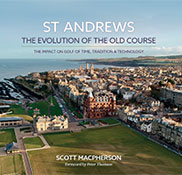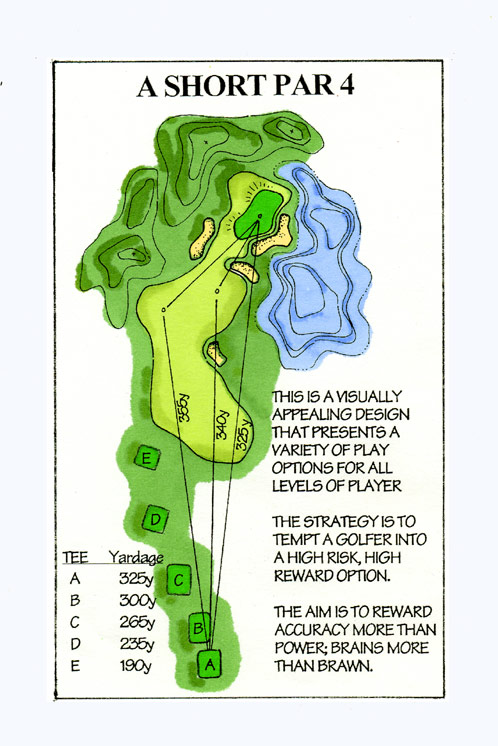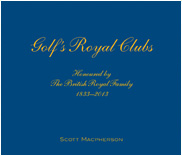GOLF CHAMPIONSHIPS ON SMGD COURSES:
At Close House – Colt Course. Sept 2017. A prestigious European Tour Championship hosted by Lee Westwood.
Broadcast worldwide from Royal Wellington Golf Club, NZ. October 2017. WOW!
The legacy continues.
Co-hosted at the award-winning Millbrook Resort near Queenstown, NZ. 2014 – 2023.
The Ideal Hole
The Ideal Hole
The most ideal hole is the short par 4. When designed properly with a small dogleg, offset green and adequate defences, they require an intellectual approach and skilful execution to attain par or better. On these holes, brains beat brawn. The old fox is on equal footing with the young buck, so as Dr Alister MacKenzie idealised, the greatest pleasure is gained by the greatest number.
While par 3’s place a golfer in a pre-determined position to view the green and execute a certain shot, they lack the width and play options of the short par 4. The par 5 can have the width but the longer accurate player always has the advantage. Short par 4’s apart from having the broadest golfing appeal, are long enough to provide mystery yet short enough from the tee that the definition of obstacles, safe havens and the overall challenge can be seen. Emotions are stirred and the head and body are engaged.
Drama comes at the short par 4 holes because the long hitters can be tempted away from their game plan. When surrounded by long par 4’s, the short hole is unfeared, and in fact creates an illusion of being easy. This is especially true for the thoughtless power golfer whose bullish tactics link a tee shot exclusively with the use of a driver. A golf architects whipping boy, the off-line long hitter suddenly realises their fatal strategic error, beware of the short hole!
Superb short par 4’s like the 316y, 12th Hole on the Old Course, where Professionals and weekend players alike struggle to decide between the safer lay-up option or the enticing shot through the pot bunkers. The 10th at the Belfry, the 14th at Loch Lomond are other high profile, dramatic short par 4’s in Britain. Both the new courses at St Andrews Bay in Scotland feature acclaimed short par 4’s. The 8th hole at Paraparaumu Beach is a respected short par 4 and the 8th at Wairakei could be more highly renown if trees did not obscure the line to the green.
In 2003 Canadian Professional Mike Weir has been a ‘major’ benefactor of the short par 4. In the final round of the Masters, Woods needed a strong start to win the tournament. After starting par, birdie, the gallery sensed a ‘Tiger charge’, but on the short 350y par 4 3rd hole, Woods went for the green, missed into the trees and ending up taking a double bogie 6, thus hijacking his own chances.
It wasn’t the first time the short hitting Weir had beaten a long hitting player on a short hole however. In February 2003, at the Nissan Open, Weir defeated Charles Howell III on the 2nd play off hole at Riviera CC. On the 315y par 4 10th, Weir layed-up off the tee, while the longer hitting Howell went for the green. Howell found a bunker and required a miraculous recovery shot to find the green, while Weir had a relatively easy 74y wedge approach into the flag. When Weir birded and Howell missed, the drama of the short hole was again evident.
The statistics of that short hole in L.A. told the story better. In the first 3 rounds Weir attempted to drive the green and played the hole in one over par. On Sunday, twice strategically opting to lay up off the tee, he played it in two under. “I finally figured it out.” he said. Meanwhile Howell used a driver each time on Sunday and played it in one over par- a three shot difference.
The greatest short par 4’s are those which temp, tease, confound, punish and reward all golfers. The green often is reachable by the longest golfers but most rewarding to the smart golfer. These special golfing gems are an important design component of a good course which offers a complete golfing examination of power, accuracy, skill and intelligence.
Post Script. – Other great short Par 4’s (Less than 350y);
– 305y, 8th Hole, Royal Melbourne (Composite Course)
– 338y, 18th Hole, Olympic Club, San Fransisco.
– 291y, 9th Hole, Cypress Point
– 325y, 11th Hole, Sunningdale, England.
AWARDS
 Winner
Winner
Excellence in Compliance Award
Royal Wellington Golf Club
PUBLICATIONS
 St Andrews
St Andrews
The Evolution of the Old Course
by Scott Macpherson
TESTIMONIALS
"Scott is a very good course designer and it's interesting to go around a course and see what he sees. I have my own ideas about courses and the way they should look, but listening to somebody like Scott, who has a lot of experience, makes you appreciate how much more there is to take into account when you are designing one."
Lee Westwood, CH Magazine, 2014.




